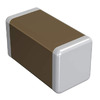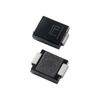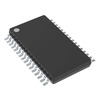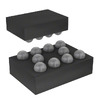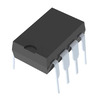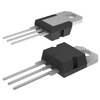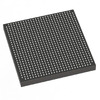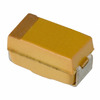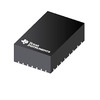CA3140 Op-Amp: Features, Circuit, and Pinout
The article introduces the CA3140 operational amplifier, renowned for its innovative BiMOS technology which blends MOSFET inputs with bipolar transistor outputs. This combination offers high input impedance and low input current, optimizing performance across diverse electronic applications.Catalog

What is the CA3140?
The CA3140 operational amplifier captures attention with its distinctive blend of PMOS and bipolar transistor technology. This architecture is crafted to achieve impressive input impedance and minimal input current, facilitated by the PMOS input for precise measurements in sensitive applications. The unique design authorizes quick response times, highly desirable in dynamic situations, while offering versatile power supply options. It accommodates voltages between 4V and 36V, maintaining performance consistency. The phase compensation ensures operational stability, finding a perfect equilibrium between speed and reliability. Zero input offset voltage is especially great in precision engineering applications, and the CA3140 excels here due to its inventive design. By reducing offsets, it enhances feedback circuit accuracy in tasks like analog signal processing, where minor inaccuracies can escalate to errors over time. This trait is exceptionally valued in sectors such as biomedical instrumentation and industrial control systems, where reliability is non-negotiable.
CA3140 Pin Configuration
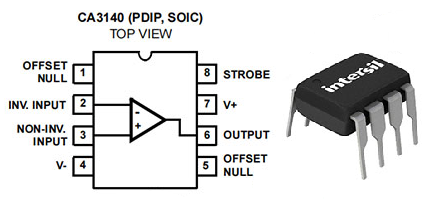
CA3140 Symbol, Footprint, and CAD Model



Features of the CA3140
• High Input Impedance: Approx. 1.5TΩ due to its MOSFET input stage.
• Low Input Current: Only 10pA, ideal for high-impedance sources.
• Wide Input Range: Operates up to 0.5V below the negative supply voltage, offering flexibility in diverse applications.
• 741 Op-Amp Compatibility: Direct substitute, reducing the need for circuit redesign.
• RoHS-Compliant: Lead-free and environmentally friendly, meeting modern standards.
• Versatile & Reliable: Ideal for precise, sensitive, and adaptable analog circuit designs.
CA3140 Technical Specifications
Technical specifications, features, parameters, and components with comparable characteristics to the Intersil (Renesas Electronics America) CA3140E.
|
Type |
Parameter |
|
Contact Plating |
Lead, Tin |
|
Package / Case |
DIP |
|
Published |
1988 |
|
Pbfree Code |
no |
|
Terminal Finish |
Tin/Lead (Sn/Pb) |
|
Min Operating Temperature |
-55°C |
|
Peak Reflow Temperature (Cel) |
NOT SPECIFIED |
|
Supply Voltage |
15V |
|
Time@Peak Reflow Temperature-Max (s) |
NOT SPECIFIED |
|
Qualification Status |
Not Qualified |
|
Temperature Grade |
MILITARY |
|
Min Supply Voltage |
4V |
|
Supply Current-Max |
6mA |
|
Architecture |
VOLTAGE-FEEDBACK |
|
Mount |
Through Hole |
|
Number of Pins |
8 |
|
JESD-609 Code |
e0 |
|
ECCN Code |
EAR99 |
|
Max Operating Temperature |
125°C |
|
Terminal Position |
DUAL |
|
Number of Functions |
1 |
|
Terminal Pitch |
2.54mm |
|
Pin Count |
8 |
|
Operating Supply Voltage |
9V |
|
Max Supply Voltage |
36V |
|
Operating Supply Current |
4mA |
|
Slew Rate |
9 V/μs |
|
Amplifier Type |
OPERATIONAL AMPLIFIER |
|
Common Mode Rejection Ratio |
90 dB |
|
Output Current per Channel |
40mA |
|
Gain Bandwidth Product |
3.7MHz |
|
Unity Gain BW-Nom |
4500 kHz |
|
Low-Offset |
NO |
|
Max Dual Supply Voltage |
18V |
|
Min Dual Supply Voltage |
2V |
|
Dual Supply Voltage |
9V |
|
Height |
4.95mm |
|
Width |
7.11mm |
|
RoHS Status |
RoHS Compliant |
|
Current - Input Bias |
10pA |
|
Input Offset Voltage (Vos) |
5mV |
|
Neg Supply Voltage-Nom (Vsup) |
-15V |
|
Voltage Gain |
100dB |
|
Frequency Compensation |
YES |
|
Low-Bias |
YES |
|
Bias Current-Max (IIB) @25C |
0.00005μA |
|
Number of Amplifiers |
1 |
|
Length |
10.16mm |
|
REACH SVHC |
No SVHC |
Schematic Diagram of the CA3140
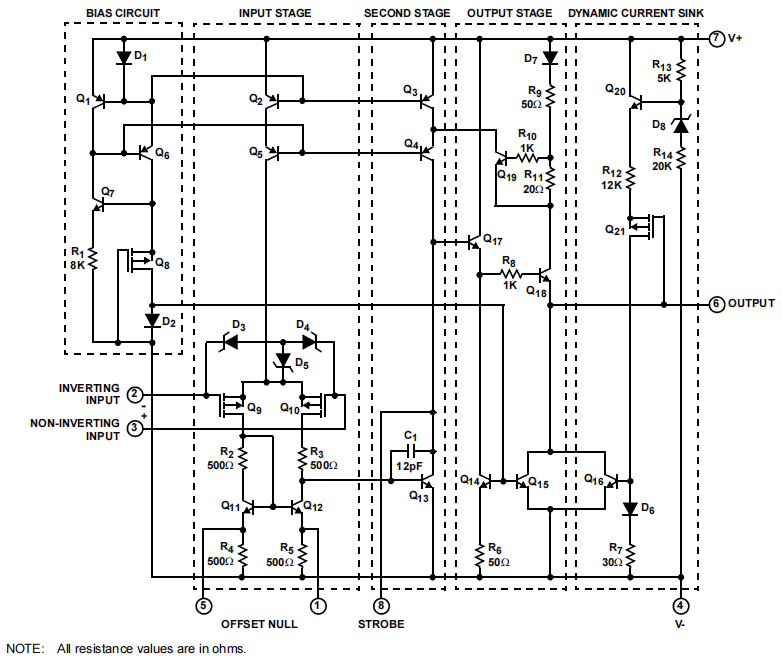
Block Diagram of the CA3140
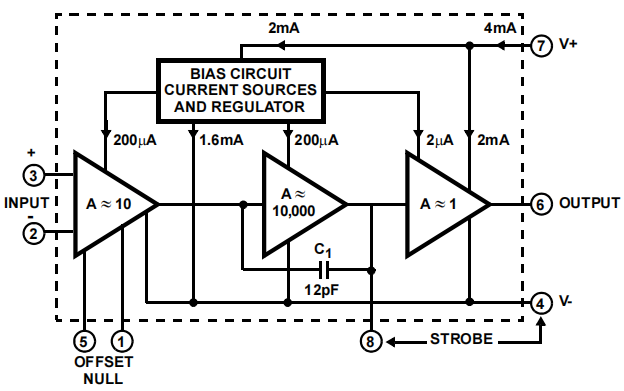
Operating Principles of the CA3140
The image depicts a schematic of a current amplifier circuit utilizing a CA3140 operational amplifier, designed to monitor and amplify load current with the capability of adjusting amplification through resistive feedback, making it suitable for precision current measurement applications.
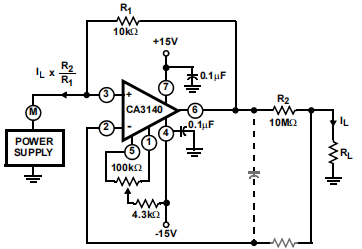
Amplifying Volts and Harmonizing with References
The CA3140 operational amplifier excels in the art of voltage amplification, harmonizing input with a specific reference. This capability becomes a core in settings where precise voltage readings are cherished, such as with sensor interfaces or lab instruments. You can appreciate the low input bias current and high input impedance, which work diligently to minimize interference and preserve the purity of the signal, enhancing both accuracy and reliability.
Enhancing Current and Playing with Resistance
The CA3140's talent for augmenting load current by manipulating chosen resistance values makes it a player in scenarios requiring discerning current measurement, frequently seen in automation and control systems of the industrial realm. With practical usage, carefully selected resistor values are applied to achieve the desired current boost while maintaining circuit stability, allowing the amplifier to deftly adapt to various load situations in dynamic testing.
Stabilizing with Capacities and Easing Oscillations
Incorporating capacitive elements within the CA3140's framework is central to strengthening circuit stability and curtailing the risk of unwanted high-frequency oscillations. For high-output demands, such as in audio processing or communications, these capacitive parts ensure signal clarity by smoothing out fluctuations, preventing potential inefficiencies or distortions.
Where Can the CA3140 Be Applied?
Voltage Followers and Buffers
The CA3140 shines in situations where signal buffering and voltage following are needed, thanks to its excellent high input impedance and remarkably low output impedance. These attributes are advantageous in contexts where maintaining signal tenacity is important. Take audio signal processing as an example, preserving minimal distortion for a desirable output, and the CA3140 effectively ensures this consistency in quality.
Comparators and Amplifiers
As a comparator, the CA3140 adeptly handles extensive ranges of input signals, delivering precise voltage level detections. Its function is central to circuits necessitating signal comparison for decision-making processes, such as those within control systems. Furthermore, when deployed as an amplifier, the CA3140's swift response facilitates quick signal amplification without substantial delay in fast-paced, dynamic applications.
Adders and Custom Designs
The adaptability of the CA3140 permits its integration into more intricate configurations like adders, where it adeptly merges multiple input signals. This capability proves in analog computing circuits, where precision in combining analog signals is an important aspect.
Using the CA3140 Operational Amplifier
A notable characteristic of the CA3140 is its dual Offset Null pins (pins 1 and 5). These pins are instrumental in addressing offset errors, a frequent issue in precision signal processing. Offset errors manifest when the anticipated zero output of an Op-Amp, given a zero voltage difference between inverting and non-inverting inputs, deviates from zero, potentially skewing signal output and causing inaccuracies in delicate measurements. By introducing an offset voltage to these pins, the output can be realigned to the intended zero level, thereby improving measurement reliability.
Offset correction can be realized by connecting a potentiometer between the Offset Null pins, allowing for adjustable offset voltage aligned with specific application needs. This hands-on approach not only corrects errors but also opens up opportunities to explore the CA3140's versatility, encouraging innovative developments in analog signal processing. Thoughtful execution of offset correction highlights the synergy between precision adjustments and achieving target system outputs, a principle echoed across various technical disciplines.
The picture below shows a test circuit of the CA3140 operational amplifier, detailing its connection to power supplies, input and feedback components, and simulated load parameters including bandwidth and slew rate.
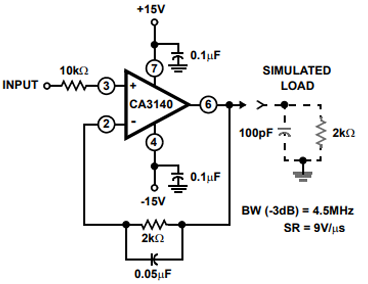
Advanced Utilization of CA3140
Operational Amplification in Automotive and Portable Meters
The CA3140 excels in single-supply operations, providing ground-referenced amplification that enhances its application in both automotive systems and portable meters. It offers precision and reliability, which play a role in interpreting vehicle sensor data and facilitating portable diagnostics. This ensures accuracy, even when faced with diverse environmental conditions.
High-Performance Sample and Hold Amplifiers
As a sample and hold amplifier, the CA3140 achieves impressive high-speed sampling rates, imperative for capturing transient signals without distortion. It is extensively employed in digital signal processing, enabling stable signal acquisition. Such precision is integral for systems relying on swift and accurate data capture.
Versatile Long Duration Timers
Acting as a timer/multivibrator, the CA3140 manages durations ranging from microseconds to hours. This timing flexibility supports diverse applications, from timing in electronic processes to managing power cycles in industrial settings, demonstrating its adaptability across various systems.
Sensitivity in Photocurrent Measurement
Used as a photocurrent meter, the CA3140 detects low-level light signals with outstanding sensitivity. This capability is use in scientific instruments like photometers, where precise light measurement is needed. It provides accurate assessments under varying lighting conditions.
Precise Peak Detection
In peak detection applications, the CA3140 identifies maximum signal levels with minimal distortion. This is important in audio processing and radio frequency applications, ensuring the integrity of peak level readings, which is good for communication systems and audio engineering.
Dynamic Active Filters
Utilized as an active filter, the CA3140 is great in refining audio signals and filtering out unwanted frequencies. This application is used in audio processing equipment, where clarity and purity in sound reproduction are important, ensuring high-quality sound output.
Reliable Comparators for Decision-Making
As a comparator in decision-making circuits, the CA3140 ensures accurate digital outputs from analog signals. In automation systems, this precise comparison enhances system responses and operational efficiency, impacting decision-making processes.
Optimizing Interfaces in Low Voltage Systems
The CA3140 facilitates interfacing in 5V TTL and other low voltage systems, boosting compatibility across various electronic devices. By enabling seamless communication between components with different voltage standards, it simplifies design, especially in electronics focused on power efficiency.
Diverse Operational Amplifier Applications
Beyond its specific applications, the CA3140 meets broad operational amplifier needs, supporting activities like signal conditioning, amplification, and mathematical operations. It underpins numerous systems commonly found in commercial and personal technology settings.
Consistent Function Generator Designs
In function generator designs, the CA3140 assists in crafting precise waveforms, benefiting both educational labs and electronic testing environments. It offers consistent and accurate opportunities for exploring and troubleshooting various signal configurations.
Tone Control Capabilities
Through managing frequency balance, the CA3140 supports tone control circuits, making it good in audio amplification systems. Its ability to adjust bass, mid-range, and treble frequencies in entertainment setups.
Stable Power Supply Management
The CA3140 plays a role in power supply regulation, delivering stable output amidst input or load changes. This application is great for maintaining the reliability of power delivery in sensitive electronic devices.
Development in Portable Instrumentation
Incorporation into portable instruments allows for miniaturization without loss of performance, an important factor for modern gadgets and diagnostic tools. The CA3140 enables to innovate, maintaining functionality in compact designs.
Effective Intrusion Detection and Alarm Systems
In intrusion alarm systems, the CA3140 enables rapid signal processing, for detecting threats promptly. Its integration enhances security measures by improving the response time and accuracy, contributing to safer environments.
Package for CA3140
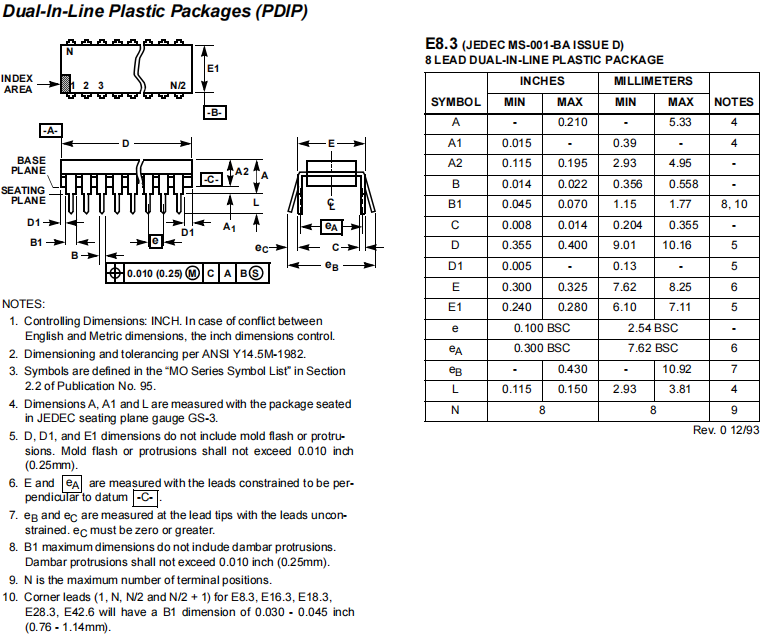
Manufacturer of the CA3140
The CA3140 operational amplifier, originally crafted by Intersil and now under the stewardship of Renesas Electronics, symbolizes growth in semiconductor innovation. Intersil's impressive history highlights its groundbreaking contributions to power management and precision simulation technologies. Their expertise caters to automotive, telecommunications, and aerospace sectors, addressing various needs that demand precision and reliability. The CA3140 stands as a standard for dependability across varying operational scenarios, marrying historical legacy with innovative potential.
Datasheet PDF
CA3140E Datasheets:
About us
ALLELCO LIMITED
Read more
Quick inquiry
Please send an inquiry, we will respond immediately.
Frequently Asked Questions [FAQ]
1. Can op-amp 007 replace CA3140?
Yes, Op-amp 007 is a viable alternative for CA3140. To achieve consistent performance, it should operate within the symmetric voltage range of ±9V to ±15V associated with CA3140. Maintaining a greater negative voltage margin than the target voltage enhances operational stability and dependability in different applications.
2. What is the role of the CA3140 chip?
The CA3140 operational amplifiers are adept at executing mathematical signal operations like addition and integration. These capabilities are used in analog computing and signal processing, domains where precision and reliability often unfold through experiential learning and testing.
3. What is the pin function of CA3140?
Pins 1 and 5: Used for input offset voltage adjustments to stabilize output with equal inputs.
Pin 2: Connects to the inverting input.
Pin 3: Associates with the non-inverting input.
Pin 4: Serves as the negative power supply.
Pin 6: Functionally designated for output.
Pin 7: Links to the positive power supply.
Pin 8: Engaged in second-stage amplification, the necessity for grasping circuit design nuances to heighten efficiency.
4. What is IC CA3140?
The CA3140 merges an operational amplifier with high-voltage PMOS and bipolar transistors on a single chip. This design facilitates low power consumption alongside high input impedance, highlighting how innovations in semiconductor technology broaden the spectrum for IC applications in tangible contexts.
5. Can CA3140 be directly replaced with NE5534?
Yes, the NE5534 is capable of substituting CA3140, offering comparable speed and voltage features. Acknowledging its potentially higher noise density is needed. Expertise and contextual insight into the project's specific needs can inform the decision between these ICs to achieve the best outcomes.

2N2369 Switching Transistor: Pinout, Alternatives, and Specifications
on November 20th
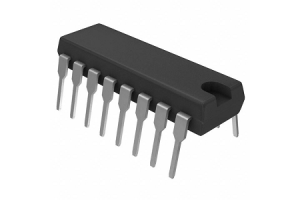
MCP3208 Analog to Digital Converters: Pinout, Applications, and Datasheet
on November 19th
Popular Posts
-

What is GND in the circuit?
on January 1th 3315
-

RJ-45 Connector Guide: RJ-45 Connector Color Codes, Wiring Schemes, R-J45 Applications, RJ-45 Datasheets
on January 1th 2839
-

Understanding Power Supply Voltages in Electronics VCC, VDD, VEE, VSS, and GND
on November 21th 2736
-

Fiber Connector Types: SC Vs LC And LC Vs MTP
on January 1th 2275
-

Comparison Between DB9 and RS232
on January 1th 1895
-

What Is An LR44 Battery?
Electricity, that ubiquitous force, quietly permeates every aspect of our daily lives, from trivial gadgets to life-threatening medical equipment, it plays a silent role. However, truly grasping this energy, especially how to store and efficiently output it, is no easy task. It is against this background that this article will focus on a type of coin cell battery that may seem insignificant on the...on January 1th 1855
-

What Is RF and Why Do We Use It?
Radio Frequency (RF) technology is a key part of modern wireless communication, enabling data transmission over long distances without physical connections. This article delves into the basics of RF, explaining how electromagnetic radiation (EMR) makes RF communication possible. We will explore the principles of EMR, the creation and control of RF signals, and their wide-ranging uses. The article ...on January 1th 1833
-

Understanding the Fundamentals:Inductance Resistance, andCapacitance
In the intricate dance of electrical engineering, a trio of fundamental elements takes center stage: inductance, resistance, and capacitance. Each bears unique traits that dictate the dynamic rhythms of electronic circuits. Here, we embark on a journey to decipher the complexities of these components, to uncover their distinct roles and practical uses within the vast electrical orchestra. Inductan...on January 1th 1823
-

CR2430 Battery Comprehensive Guide: Specifications, Applications and Comparison to CR2032 Batteries
What is CR2430 battery ?Benefits of CR2430 BatteriesNormCR2430 Battery ApplicationsCR2430 EquivalentCR2430 VS CR2032Battery CR2430 SizeWhat to look for when buying the CR2430 and equivalentsData Sheet PDFFrequently Asked Questions Batteries are the heart of small electronic devices. Among the many types available, coin cells play a crucial role, commonly found in calculators, remote controls, and ...on January 1th 1816
-

Comprehensive guide to hFE in transistors
Transistors are crucial components in modern electronic devices, enabling signal amplification and control. This article delves into the knowledge surrounding hFE, including how to select a transistor's hFE value, how to find hFE, and the gain of different types of transistors. Through our exploration of hFE, we gain a deeper understanding of how transistors work and their role in electronic circu...on November 21th 1814









